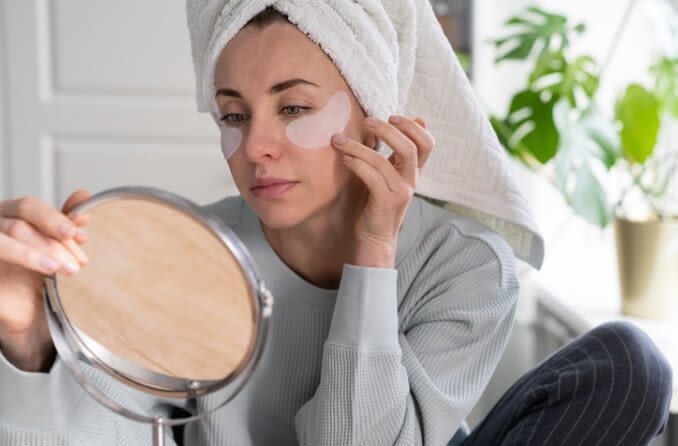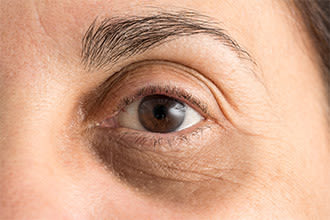Dark circles under the eyes: Causes and how to get rid of them

What causes dark circles under the eyes?
We often associate dark circles under the eyes with being tired or not getting enough sleep. While these things may contribute to the appearance of dark circles, there are other common causes, such as poor diet, genetics, trauma, smoking and sun exposure.
Dark circles often look purple, blue or dark brown. It depends on the color of your skin. Having dark circles is common and rarely something to be concerned about. But for cosmetic reasons, many people wish to get rid of these dark circles.
Fortunately, there are at-home and doctor-recommended remedies for getting rid of dark circles under the eyes.
How do I know if I have dark circles under my eyes?
To find out whether you have dark circles under your eyes, simply look in the mirror and see whether they’re present.

Dark circles can form under the eyes from stress or lack of sleep.
Dark circles are typically most noticeable near the inner corner of the eye and then spread (or “circle”) under the eye, toward the outer corner. The skin in this area may appear darker than the rest of your face, though this varies depending on your skin tone.
In people with fair skin, the dark circles may appear blue or purple, whereas people with a deeper skin tone may have circles that appear dark brown or black. It’s possible for eye puffiness to accompany the dark circles, though one can be present without the other.
Having dark circles under the eyes is not a medical concern. However, people often feel the dark circles affect their appearance and want to remove them for cosmetic reasons.
Causes of dark circles under eyes
It’s possible that the dark circles under your eyes are because of the natural aging process. As we get older, our skin loses collagen and becomes thin. Thinner skin can make the blood vessels beneath it more visible, making the under-eye area appear darker.
Besides age, here are a few likely causes of the dark circles under your eyes:
Allergies
The body releases a chemical called histamine in response to an allergen, such as dust or pet dander. Histamine causes the blood vessels to dilate, which can make them more visible from under your skin.
Excessive rubbing of the eye area
Histamine can cause the eyes to itch, which can prompt rubbing and scratching around the eye. However, excessive rubbing can result in swelling and inflammation or cause the blood vessels under the skin to break, which can cause dark circles.
Trauma
An accident that involves the eye being hit by an object can cause bruising around it (commonly referred to as a black eye), which can appear as dark circles. It’s also possible for a black eye to occur after cosmetic facial surgery, dental surgery or a severe sinus infection.
Genetics
In an article published in the Spokesman Review, Dr. Eve Glazier and Dr. Elizabeth Ko explain that genetic hyperpigmentation is a common cause of dark circles under the eyes. In these cases, the skin around the eyes is darker than it is on the rest of the face — a trait that can be inherited from a parent or family member.
Fatigue
Failing to get adequate sleep can cause your skin to appear dull. The paleness of the skin allows the blood vessels and darker tissues to become more visible through it. A poor night’s sleep can also cause bags under the eyes that may cast a shadow and give the illusion of dark circles.
Dehydration
Proper hydration is important for your overall health and appearance, as hydrating regularly creates a fresh, glowing plumpness to the face. The eyes are very close to the underlying orbital bone, so when we’re dehydrated, the eyes can look sunken or hollow, and dark circles can appear.
Hyperpigmentation
Hyperpigmentation occurs when patches of skin appear darker than the rest of the skin in that area. It can happen anywhere on the body, though it’s most commonly seen on the face and hands. While genetics can play a role in hyperpigmentation, other factors such as sun exposure, hormones or injury can also be responsible.
Smoking
According to a 2008 study done by the American College of Chest Physicians, cigarette smokers are four times more likely to feel unrested after a night’s sleep. This is likely because smokers spend less time in deep sleep than non-smokers. As mentioned earlier, fatigue can lead to under eye bags and dark circles.
Anemia (iron deficiency)
Proper levels of iron in the blood are important for circulating oxygen throughout the body. People with anemia can have dark circles under their eyes because there isn’t enough oxygen reaching the tissues in that area.
Other causes of dark circles under the eyes include:
Alcohol consumption
Fluid retention
Nasal congestion
Atopic or contact dermatitis
Poor diet
Certain thyroid conditions
Eye drops to treat glaucoma
SEE RELATED: Swollen eyelid: Causes & how to treat a swollen eyelid
Risk factors for dark circles under the eyes
You may be at a higher risk of developing dark circles under your eyes if you:
Are genetically predisposed – Studies have shown that a person is more likely to develop dark circles under their eyes if people in their immediate family also have them.
Are experiencing natural aging – Collagen loss and thinning of the skin is a universal sign of aging. These natural changes can make dark circles more noticeable, especially in the hollow area beneath the eye, called the tear trough.
Have a medium or deep skin tone – While dark circles under the eyes can certainly affect people with pale or light skin tones, it is seen more often and affects more people with deeper skin tones. Changes in skin pigmentation are the source.
How to get rid of dark circles under eyes
Getting rid of dark circles under the eyes can be achieved using these at-home or doctor-recommended treatments.
Home remedies
Get more sleep – Most adults should try to get seven to eight hours of sleep each night. This should create a brighter complexion and reduce the appearance of dark circles.
Drink plenty of water – The recommended daily water intake is around 13 cups for men and 9 cups for women. If you don’t like drinking water, try flavored sparkling or still water to keep your skin and body hydrated.
Cold compress – Placing a cold compress on the eyes will constrict the blood vessels under the skin, making them less visible and reducing the appearance of dark circles.
Wear sunscreen daily – Applying broad-spectrum sunscreen whenever you plan to go outside, even if it’s just to drive to work and back, helps prevent skin cancer, premature aging and hyperpigmentation associated with dark circles.
Stay elevated while you sleep – Keeping your head elevated while you sleep prevents fluid from collecting under the eyes, which can make them look puffy in the morning and cast shadows under the eyes that look like dark circles.
More home remedies for dark circles include:
Getting facials
Placing tea bags or cucumbers on the eyes
Quit smoking
Reducing alcohol and sodium intake
Using antioxidant skincare products
Eating iron-rich foods
Concealing with makeup
Treatments your doctor may suggest
Lightening cream – Bleaching creams can lighten the skin and counteract the effects of hyperpigmentation. Common creams include chemicals such as tretinoin and hydroquinone. Results usually become visible after three months of consistent use.
Fillers – Fillers can reduce the appearance of dark circles by injecting platelet-rich plasma or hyaluronic acid gel into the under-eye area. This treatment is best for dark circles that are caused by thinning skin or collagen loss.
Chemical peels – Chemical peels use powerful acids, such as glycolic acid, to tighten skin and lighten hyperpigmentation.
Other medical treatments for dark under-eye circles include:
Laser therapy
Kojic and Azelaic acid
Vitamin C
Retinol
Surgery
READ MORE: Eyelid surgery: What it is, how much it costs, what the risks are
What causes dark circles under the eyes? Medical News Today. August 2019.
6 causes of dark under-eye circles, according to a dermatologist. Insider Health. October 2020.
Ask the doctors: Genetics play a large role in under-eye circles. The Spokesman Review. April 2019.
Dark circles under the eyes. DermNet NZ. July 2015.
Hyperpigmentation. American Osteopathic College of Dermatology (AOCD). Accessed June 2021.
Smoking linked to sleep disturbances. American College of Chest Physicians. February 2008.
Periorbital hyperpigmentation: A comprehensive review. Journal of Clinical and Aesthetic Dermatology. January 2016.
Sunscreen FAQs. American Academy of Dermatology Association. Accessed June 2021.
How to get rid of bags under your eyes. Cleveland Clinic. April 2021.
How much sodium should I eat per day? American Heart Association. May 2018.
Infraorbital dark circles: A review of the pathogenesis, evaluation and treatment. Journal of cutaneous and Aesthetic Surgery. June 2016.
Page published on Tuesday, 17 May 2022






